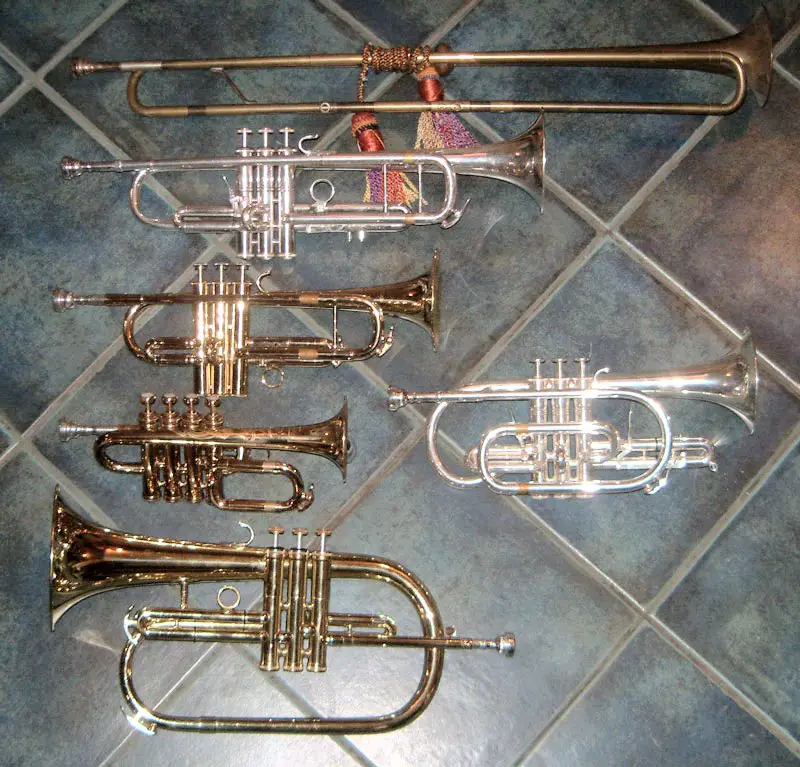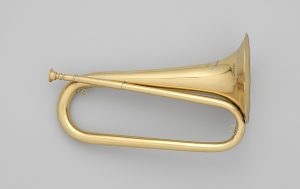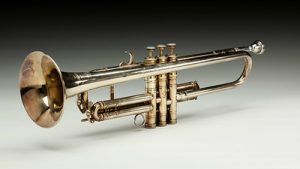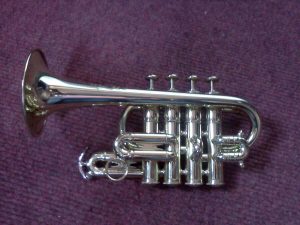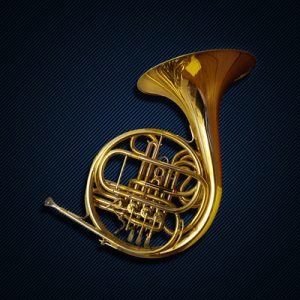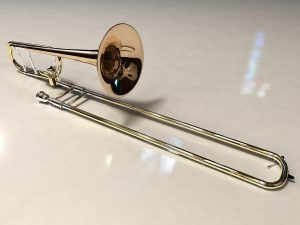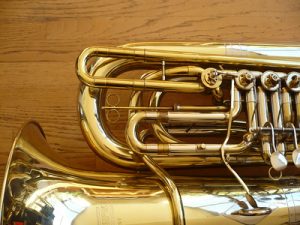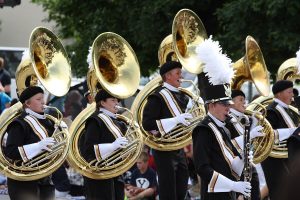This article will educate you on brass instruments and provide you with a guide as well as a comprehensive list of brass instruments for you to peruse.
The brass section of the orchestra is responsible for the loudest sounds because, as you might expect, their name comes from the metal from which they are fashioned. In contrast to some of their forebears, modern brass instruments are constructed entirely out of the metal.
How the Brass Instruments Operate and Generate Sound
To summarize, brass instruments resemble long pipes that broaden out into a bell shape at the end of the instrument. The different shapes of the pipes were carefully molded into different forms in order to make them easier to hold and play.
Brass instruments are similar to wind instruments, such as flutes, clarinets, and saxophones, in that the sound is produced by the player exhaling into the instrument. Brass players vibrate their lips against the metal cup or bowl-shaped mouthpiece, as opposed to woodwind players who blow into the reeds of their instrument.
The sound of the lips vibrating is what gives brass instruments their distinctive sound. The mouthpiece’s job is to amplify that sound and make it louder. Valves on brass instruments typically take the form of buttons and are attached to the instruments’ lengthy pipes.
When you press the valves, various sections of the pipe open and close. By pressing various valves and adjusting how strongly they buzz their lips, the players can change the instrument’s pitch and sound.
13 Most Common Brass Instruments
1. Bugle
First on our list of brass instruments is the bugle – known for being a very easy instrument to play. Why? Because it does not have any valves or other devices that can change the pitch. As a result of this, the bugle can only play a total of five notes.
The “bugle call” signifies the beginning of each day in the military as well as in the Boy Scouts, and bugles are commonly associated with both of these organizations.
2. Trumpet
Similar to the violin, nesxt on our list of brass instruments is the trumpet – the smallest member of its family and as a result, it is capable of playing the highest pitches.
To change the pitch, a trumpet player holds the instrument horizontally, vibrates their lips into the mouthpiece, and presses down on the three valves at the same time.
There could be two trumpets, or there could be four trumpets, depending on the size of the orchestra. The rhythm section would not be complete without the contributions of melody and harmony from these instruments.
Joseph Haydn composed the “Trumpet Concerto” in 1796 as a gift for his trumpet-playing acquaintance Anton Weidinger. Even now, it is still frequently cited as one of the best pieces ever written for the trumpet.
3. Cornet
There are some similarities between the trumpet and the cornet, however the cornet is smaller, has a little softer tone, and a conical barrel.
Although several notable composers have written parts for cornets, including Berlioz (the first significant composer to do so), Tchaikovsky, Edward Elgar, and Igor Stravinsky, the instrument is rarely played in modern orchestras (with a famous solo in his ballet Petrushka).
Modern brass wind instruments, like cornets, are played by the player’s lips vibrating in the mouthpiece. This causes the instrument’s associated pipe or tubing to emit a vibrating column of air.
The instrument’s valves allow for chromatic playing.
4. Flugelhorn
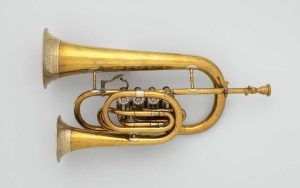
Source
Obviously, “Flugelhorn” is a German word. The Seven Years’ War is where the military first used this horn, whose name translates to “wing” or “flank” in English (1756-1763).
The flugelhorn is most analogous to the trumpet and the cornet, albeit the flugelhorn’s conical bore is more prominent.
The flugelhorn, like other brass instruments, typically has three piston valves, and players finger the instrument in the same way as they would any other brass instrument.
Although flugelhorns are frequently heard in jazz and British-style brass bands, they are used in orchestral music only sporadically. This is in contrast to the frequency with which they are used in jazz.
Two of the most well-known works in this category are “Threni” by Stravinsky and “Ninth Symphony” by Ralph Vaughan Williams.
5. Piccolo trumpet
Understandably, the piccolo trumpet is the smallest of the trumpet family and has a higher pitch than the standard (B) trumpet by an octave. Piccolo is the Italian word for “small.”
Although it is not played in orchestras all that frequently, it is featured in one of the most well-known pieces of orchestral music written during the Baroque period, which is Johann Sebastian Bach’s Brandenburg Concertos.
When the Beatles were recording their iconic song “Penny Lane,” Paul McCartney was so moved by this piece that he requested a solo performance on this instrument.
6. French horn
The French horn, on the other hand, has its roots in France and is unquestionably a horn, as opposed to the English horn, which is neither English nor a horn.
It was developed from the standard French hunting horn of the 1700s. If you were to stretch out the tubing that makes up a French horn, it would reach a length of 18 feet. This helps explain their one-of-a-kind appearance.
In addition, this is the horn most commonly heard in orchestras, with four French horns being used by composers as far back as Beethoven.
The distinctive tone of the horn has been interpreted as a representation of hunting by a number of composers, including Leopold Mozart, Gustav Mahler, and others.
7. Mellophone
In the same way that euphoniums and flugelhorns have conical bores, mellophones can have either two or three valves depending on their design.
Since sound dissipation occurs more quickly outdoors, these brass instruments with an outward-facing bell are frequently used in place of French horns by marching bands and drum and bugle corps.
As a result of this, mellophones are only occasionally used in orchestras.
8. Euphonium
As was mentioned earlier, the euphonium also has a conical bore, and it can have anywhere from three to four valves.
Euphoniums, which are medium-sized brass instruments, can have their music written in either the treble clef or the bass clef because their range can span both of these important clefs.
Even though solo euphonium compositions didn’t become common until the second half of the 20th century, the instrument has played a significant role in ensembles since the nineteenth century.
9. Trombone
The trombone is one of a kind because it is the only brass instrument where the pitch is altered by means of a slide rather than valves.
Slide is moved to one of seven positions with the right hand, and the instrument is played by buzzing the lips into the mouthpiece while held horizontally.
The range of sound produced by trombones is comparable to that of cellos and bassoons, and there are typically three of them in an orchestra.
The three trombones are able to harmonize with one another most of the time. Many well-known composers, such as Gustav Holst and John Cage, have written pieces specifically for the trombone.
10. Tuba
Surprisingly, despite the fact that it has the lowest pitch of all brass instruments, the word “tuba” in Latin actually refers to a trumpet. The tuba, like other instruments in the brass family, generates sound by having the player vibrate their lips into its mouthpiece.
There is typically only one tuba in an orchestra because it is the lowest instrument in the brass section and it helps to amplify the low frequencies of the string and wind instruments.
Famous composers like Stravinsky, Holst, Prokofiev, Wagner, and Mahler all featured prominent tuba parts in their works.
11. Sousaphone
You might be curious about the meaning of the name of this one. It was famous American bandleader John Philip Sousa who, in 1893, had J.W. Pepper design the sousaphone and gave it its namesake.
The sousaphone’s range is comparable to that of the tuba, but it’s much more manageable in terms of portability. Due to this feature, sousaphones are frequently used in military bands.
12. Cimbasso
Last on our list of brass instruments is the cimbasso, a family member of the trombone, can produce tones that are both friendly and foreboding.
It has a cylindrical bore and anywhere from three to six valves, either piston or rotary. It has the same tonal range as a tuba or contrabass trombone.
Famous opera composers like Giuseppe Verdi and Giacomo Puccini frequently include the cimbasso in their works.
13. Helicon
Like the sousaphone, which can be thought of as an atypical helicon, the helicon belongs to the tuba family.
In the 1860s, helicons, which are descended from the “saxhorn” or “saxtuba,” became widely used in cavalry and artillery-mounted bands due to their outward projection, making them ideal for use in outdoor settings. They were later adopted for use primarily in military marching bands.
List of brass instruments in orchestra
When it comes to today’s orchestral music, the brass section is indispensable.
It is typical for orchestras of this type to be divided into four sections, namely the trumpet section, horn section, trombone section, and tuba section.
The total number of players in a standard Brass Instrument Orchestra can range anywhere from 12 to 24 people.
The first known use of brass instruments was in military bands during the 16th century. Brass instruments orchestras date back to that time period.
Since then, they have gained more popularity not only in concert halls but also in symphony orchestras thanks to the powerful sound that they produce, which gives any musical piece that they play additional color and depth.
A Concise Overview Of The History Of Brass Instruments
Brass instruments are classified as “aerophones,” which are instruments that produce sound when air is blown into them.
Although modern brass instruments are always created from brass, the earliest known examples of such instruments can be traced back to different ancient and medieval cultures.
Instruments such as trumpets have been discovered in ancient Egyptian, Scandinavian, and Chinese tombs, demonstrating the pervasiveness of music throughout human history.
In the Americas, trumpets can be found in Peruvian art dating back to 300 AD. At this time, they would be crafted from metals like bronze or silver if not made from animal bone.
In order to better command armies, trumpets first made their appearance in the military during the medieval period.
Despite the fact that this is still frequently connected to the military today, Vegetius’ De re militari, which states that “the music of the [Roman] legion consists of trumpets, cornets, and buccinae [an ancient Roman brass instrument],” references the ancient practice of using brass in the military.
However, it wasn’t until the Renaissance that brass instruments started taking the form we know them by today.
The creation of the earliest “S”-shaped trumpet that we are aware of took place at the beginning of the fifteenth century. In the latter half of that century, the slide trumpet paved the way for the development of the trombone, which is the only brass instrument that does not have valves.
Composers of the seventeenth and eighteenth centuries began writing a significant increase in the amount of music for brass instruments.
The most well-known examples of this are Mozart’s Don Giovanni and The Magic Flute, both of which feature prominent trombone work to emphasize supernatural or religious effects.
Final thoughts on list of brass instruments
Brass instruments are consistently ranked among the most widely played musical instruments all over the world. The term “labrosone,” which is another technical term for a brass instrument, literally translates to “lip-vibrated instruments,” which is exactly what these things are.
Brass instruments, whether they are used in orchestras, marching bands, jazz bands, big bands, or military applications, offer a strong, commanding sound that can also be surprisingly delicate and subtle.
Although the earliest horns were likely not made of brass, the modern instruments have a striking luster due to their metal construction.
When they started being used regularly in classical orchestras in 1815, brass instruments gained a lot of popularity that hasn’t gone away to this day.


